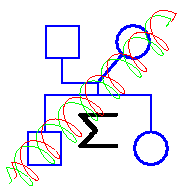
1. (Based on Lange Ch 6, #1, and an example of Cavalli-Sforza and Bodmer)
In an idealized infinite population, 10% of people marry their first cousins
(kinship coefficient 1/16), 25% marry their second cousins (kinship coefficient
1/64), and the remaining 65% marry unrelated individuals. All marriages have
the same family size distribution. Consider a very rare recessive trait,
with allele frequency q.
(a) Show that the mean inbreeding coefficient in the population is just over
1%.
(b) Show that the overall probability an individual is affected is
q(0.01 + 0.99q)
(c) Show that the probability an affected individual is the child of a
first-cousin marriage is 0.00625(1+15q)/(0.01 + 0.99q).
(d) How small must q be in order that the posterior probability an affected
individual is the child of a first-cousin marriage is larger than the posterior
probability the child is from a second-cousin marriage. (Answer : 0.015 (approx).)
2.
Consider a male with inbreeding coefficient f1 who is
unrelated to a female individual who has inbreeding coefficient f2.
The individuals have two offspring B and C.
(a) Show that the probability that B and C receive the same gene
from their father is (1+f1)/2. Show that the
probability that B and C receive the same gene from their mother
is (1 + f2)/2.
(b) Show that the probabilities ki (i=0,1,2) that B and C
have i genes IBD are
k2 = (1 + f1)(1 + f2) /4
k0 = (1 - f1)(1 - f2) /4
k1 = 1 - k0 - k2
and that the coefficient of kinship between B and C is
psi(B,C) = (2 + f1 + f2) /8
(c) Suppose the first child has a recessive trait, the allele for
which has frequency q. If nothing is known about the trait in the
parents, what is the probability the second child will have this trait
also? What is the probability the second child will be an unaffected
carrier for the trait?
(d) Suppose now it is known that neither parent has the trait, but
again the first child is affected.
What is the probability the second child will have this trait
also? What is the probability the second child will be an unaffected
carrier for the trait?
3. (based on Crow and Kimura, Ch 4, #9)
This makes exact the notion due to Wright that gene identity by
descent leads to correlations between relatives.
Consider a particular allele A with allele frequency q, and define
indicator random variables I(g), for a gene g, where I(g)=1
if the allelic type of gene g is A, and 0 otherwise.
(a) Show E(I(g)) = q, and var(I(g)) = q(1-q)
(b) Show that for genes g1 and g2 segregating from B and from C,
the correlation between I(g1) and I(g2)) is the kinship
coefficient between B and C.
(c) If g1 and g2 are the two genes in an individual, shown that
the variance of (I(g1)+I(g2)) is 2q(1-q)(1+f), where f is the
inbreeding coefficient of the individual.
(d) If g1 and g2 are the genes in a parent B, and g2 and g3 are the
genes in his child C (that is, the g2 gene is the one inherited
by C from B), show that the correlation between (I(g1)+I(g2)) and
(I(g2)+I(g3)) is
(1+2fC+fB)/(2((1+fC)(1+fB))1/2)
where fB is the inbreeding coefficient of B, and fC
is the inbreeding coefficient of C.
4. (based on Crow and Kimura, Ch 4, #15)
An individual B has phenylketonuria, a rare recessive condition, for
which the allele frequency q is 0.01. What is the probability that
B's relative C has phenylketonuria if
(a) C is a first cousin of B
(b) C is a nephew of B
(c) C is a double first cousin of B
(d) C is a quadruple half first cousin of B
(Note the kinship coefficient between B and C is the
same for relationships (b), (c) and (d).)